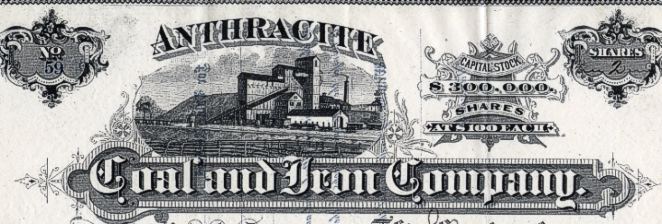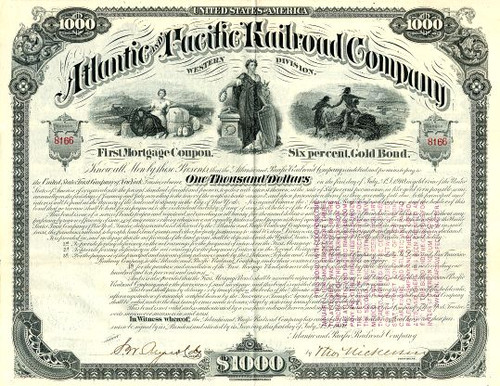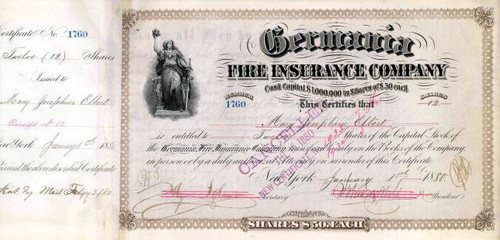Beautiful certificate from the Anthracite Coal and Iron Company issued in 1880. This historic document was printed by the F. Halstead Company, H. Y. and has an ornate border around it with a vignette of the mine processing facility next to railroad cars. This item has the signatures of the Company's President, Grinnell Burt and Secretary, W. P. Richardson and is over 129 years old. The certificate was issued to Thomas P. Remington and is signed by him on the back. 
Certificate Vignette Early Days in New England By Henry Martyn Burt, Silas Wright Burt - 1893 GRINNELL BURT [seventh Generation; Benjamin", JAMES", Daniel4, Benjamin', David*, Henry'.] Of the many descendants of Henry Burt, none have been more actively engaged in business enterprises than Grinnell Burt of Warwick, Orange county, N. Y. His father, Benjamin Burt, was a son of James Burt, who was notably one of the most prominent men associated with the political and business affairs of Orange county, N. Y. Grinnell Burt was born in the village of Bellvale, November 7, 1822. He received his early education at the public school in his native village. At the age of fifteen, his father and mother both being dead, lie emigrated to the state of Ohio, where he remained several years, returning to Bellvale in 1841. With a natural aptitude, and a mind that quickly grasped all opportunities for the development of the resources of the country, he became interested in railroad projects, a field for which he was eminently fitted. Meanwhile, his love of the law prompted a course of reading and study, which, as subsequent events proved, was of great value to those with whom he became associated as their representative in the corporate interests committed to his charge. In fact, he developed so fully the necessary qualifications of a successful lawyer and advocate that his friends in the legal fraternity urged him to make application for admission to the bar, and make the practice of law his profession. His inclination to engage in other pursuits led him to abandon the law and all other projects, that he might devote himself more especially to the organization and management of railroads, the development of which was then comparatively in its\ infancy. As early as 1852, he became identified with the building of a railroad from Newburg, on the Hudson river, to the Delaware river, south of the Delaware Water Gap. A company was organi2ed for that purpose, and the engineers located the line. The project had many prominent advocates, both in New York and New Jersey, notably Jeffrey Wisner, James Burt, Edward L. Welling, Abram S. Hewitt, Governor Daniel Haines, Colonel Samuel Fowler, Colonel Edsall and others. Owing to the want of proper support, the project was ahandoned. In 1859, with others, Mr. Burt organized the Warwick Valley Railroad, extending from Greycourt, on the Erie Railroad, to Warwick, N. Y. In 1878, he organi2ed the Wawayanda Railroad, extending the latter road to McAfee, N. J. In 1881 and 1882, the road was built from McAfee to Belvidere, on the Delaware river, under the charter of the Pequest and Wallkill Railroad. In 1882, these various roads were consolidated under the corporate name of Lehigh and Hudson River Railroad. Mr. Burt has been both president and general manager of the above lines, in their separate or consolidated capacity, from 1859 to 1893, being, perhaps, at this writing, the oldest railroad president in the State of New York continuously in service. During the years that he was engaged in gradually building through this line, connecting the Lehigh coal field and the New England States, he took an active part in the projection and management of other important railroad developments. In 1867-68, he built the Middletown, Unionville, and Water Gap Railroad (now forming a part of the line of the New York, Susquehanna and Western Railroad). In 1875, the road becoming financially embarrassed, Mr. Burt was elected president and by his sagacious management brought it out of its chaotic condition and placed it on a sound footing. In 1878-79, with General James H. Negley, of Pittsburgh, Pa., and others, he projected and built forty miles of the Pittsburgh and Western Railroad (now a part of the Baltimore and Ohio system), during which time, he was superintendent of construction and operation. From 1883 and 1885 he was president of the Cincinnati, Van Wert and Michigan Railroad (now known as the Cincinnati, Jackson and Mackinaw). Under his administration this road was extended about one hundred miles. He was one of the reorganization committee of the Toledo and Ohio Central, which is generally conceded to have been one of the most successful reorganizations of a bankrupt company ever effected. Mr. Burt was a director of this company for three years after. He was also one of the committee to reorganize the New Jersey Midland, now the New York, Susquehanna and Western. He was for several years a director and subsequently president of the Kanawha and Ohio Railroad, serving until the reorganization in March, 1890. In 1875 he was appointed by Governor Samuel J. Tilden one of the three commissioners to remove obstructions from the Delaware river, for which an appropriation had been made. During the discharge of this duty, as a result of practical methods, Mr. Burt and Governor Tilden became fast friends. The commission served without pay, and after their work was thoroughly done, a balance remained in their hands, which was deposited in the state treasury, a result so unusual in the expenditure of public money that it excited no little comment. Two years later, at the solicitation of Governor Tilden, who was heavily interested, Mr. Burt assumed the management of the New York and Greenwood Lake Railroad, it being the purpose of Mr. Tilden and other capitalists concerned to extend this line to Albany via the Wallkill Valley. The project, however, miscarried, and the road was sold to the New York, Lake Erie and Western. Mr. Burt has been identified with various projects for bridging the Hudson, notably the Storm King, Poughkeepsie and Peekskill bridges, and since the completion of the Poughkeepsie bridge the Lehigh and Hudson River Railroad has been connected with the bridge lines by the Orange County Railroad, which is operated by the Lehigh and Hudson. In 1874 Mr. Burt was appointed by Governor Dix a trustee of the Middletown State Homeopathic Hospital, serving many years as a member of the executive and building committees, and for several years past has been president of the institution,--one of the most successful in the state. Since he settled in the village of Warwick, his name has been so closely associated with public affairs that a sketch of his life would necessarily comprise a history of the village and surroundings for the past forty years. He was one of the founders of the First National Bank of Warwick, and is its vice-president. With one or two others, he procured the incorporation of the village, under a special charter, and was one of the water commissioners to build the reservoir supplying the village with water. In educational matters he has always taken a great interest; was one of the incorpo- rators of the Warwick Institute, and for thirty-two consecutive years a member of the board of education. In politics, as in railroad affairs, he has never allowed tempting aspirations or suggestions to alter the course prompted by his own convictions. His independence in political matters is well known, in fact, he might be characterized as an original " Mugwump." In early life he was a Democrat, and voted with the party until the formation of the Republican party, when, realizing that the Democrats had become too intimately associated with the extension of slavery, the natural sequence was that he should cast his lot with the new organization and he earnestly supported the Republican party in all its measures up to 1872. At that period, seemmgly, lo his mind, its mission was accomplished, and he again resumed his association with the Democratic party, they best representing a public policy that would contribute best to the welfare of the masses. Having great repugnance to anything that might be deemed machine politics, he, as a matter of course, was one of the first to protest against what has been characterized Governor David B. Hill's " snap convention." He was sent as a delegate to Chicago to assist in promoting the nomination of Grover Cleveland for President, which mission was successful, and the nominee endorsed by the people. Possessed of a robust physique, a strong will, an independent nature and an aggressive spirit, Grinnell Burt has achieved success where men of more pliant mould would have failed. His rugged honesty of purpose has never been questioned, even when most bitterly assailed by those whose opinions or interest he opposed. Mr. Burt has been a close observer of men and affairs, and his opinions as a rule are based upon a keen analysis of merit. He has never been a follower, but is always original in thought and action. As a public speaker he has a remarkable faculty for direct and pointed argument, while his ready wit and ofttimes brilliant sallies make him a favorite with all classes. Many of his telling epigrams and witticisms are by-words among his fellow townsmen, which is perhaps as great a compliment as one could ask. Socially he is one of the most interesting of men. With a mind stored with the gleanings of a busy life, his conversation teems with reminiscences of the past, particularly of prominent men and measures, while his fund of anecdote is inexhaustible. No one loves a good story better or can tell one with greater zest than he. He has always been a favorite among the employes of the roads that he has managed, and his fairness and impartiality is perhaps the reason that no strike has ever occurred on any of the lines which he has operated. In 1850, Mr. Burt married Miss Jane S. Van Duzer, daughter of Isaac Van Duzer, of Warwick, a woman of charming presence, intelligence and refinement. Their married life was a happy one. Mrs. Burt died in 1871, leaving four daughters, two of whom are married. In 1886, he married Miss Louise Pierson, daughter of Samuel V. Pierson, of Middletown, N. Y., a lady of rare personal worth and a great favorite with a wide circle of friends, possessing all those womanly qualities that win the esteem of those with whom she is associated. This union has added to the family circle two sons. Mr. Burt passes his leisure hours at home with his interesting family and his well-stocked library. Besides other matters that engage his attention, he is especially interested in the study of geological and mineralogical subjects, having made a fine collection of minerals which now adorn the shelves of his cabinet. In conclusion, it is very proper to say that Grinnell Burt is a representative of that type peculiar to America--emphatically a self-made man.

Certificate Vignette













